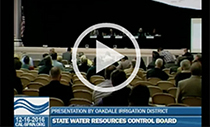The Issue
On Sept. 15, the state announced its plan to unfairly take 300,000 acre-feet of water each year from the Stanislaus and two other Central California rivers. This water grab could devastate our regional economy while doing little to help salmon. OID and SSJID joined other public agencies and private citizens who oppose this misguided plan. The state recently held five public hearings, and is compiling hundreds of public comments into a final proposal, expected sometime this spring. A vote could be taken early this summer.
OID and SSJID’s Ideas
Watch video clips from the presentation made by General Managers Steve Knell of the Oakdale Irrigation District and Peter Rietkerk of the South San Joaquin Irrigation District at the state water board’s public hearing on Dec. 16, in Stockton.

What Can You Do?
Write a letter to the water board. We’ll send it for you. Share our easy-to-use form with your friends and family. Public comments will be accepted until March 17.
Support your state legislators, county supervisors and city councils, who are united in their opposition. Let them know you’re on their side.
Send a letter to your local newspaper expressing your thoughts on the state’s proposal.
THE IMPACT: What Do Increased Unimpaired Flows Mean For …
Farmers
If the state forces irrigation districts to cut surface deliveries to farmers, they have two choices: Fallow a portion of their land or pump more groundwater. Thousands of acres could be taken out of production if unimpaired flows are increased on the Stanislaus River.?
Businesses
Agriculture in San Joaquin and Stanislaus counties is worth more than $6 billion a year. Those dollars circulate over and over throughout the regional economy. The state’s plan could risk thousands of jobs in farming, trucking, food processing and related industries.?
Recreation
New Melones and Tulloch reservoirs are magnets for tens of thousands of people who enjoy houseboating, water skiing, fishing, hiking, bird watching and simply getting out in nature. The state’s plan means New Melones may never refill.
?
Our responsibility is to sensibly manage water for many purposes
The Stanislaus River is in serious jeopardy due to five years of drought and now a plan by state regulators to increase “unimpaired flows.” That plan would take water away from agriculture, homes and recreation, and reduce the water in our reservoirs, eliminating the safety net for people, business and the environment.
This unnecessary water grab could devastate people and the regional economies in the valley – where agribusiness and recreation directly contributes more than $6 billion annually to Stanislaus and San Joaquin counties – as well as the foothills – where New Melones and Tulloch reservoirs are located.
Our science and research can help fish thrive in the Stanislaus River
Since 1993, the South San Joaquin and Oakdale irrigation districts have jointly funded through the Tri-Dam Project the work of FISHBIO, one of the world’s leading fisheries research, monitoring and habitat restoration organizations. It has an office in Oakdale staffed with people dedicated to understanding the Stanislaus River and the fish that live in it.
Join our mailing list and receive updates on water-related news about the Stanislaus River.
Our conservation efforts save water during the drought
Together, SSJID and OID have invested more than $110 million in the past decade in conservation projects to modernize and improve their districts. Those efforts were driven to preserve and protect their water resources and historic water rights by being good stewards. Even before the drought began, they and their customers were committed to water conservation. They are dedicated to science-based policies and practices that benefit agriculture, the environment, and domestic and recreational users.





